On Its Third Birthday, Apex Legends Continues to Pave the Way For the Future of FPS and Battle Royale Games
At the end of 2021, Kotaku’s Renata Price responded to Halo Infinite devs who claimed “Halo is for everyone,” pointing out the myriad of ways that the game is, at every level, not. I finally tried the famed multiplayer over the holiday break, and after 15 minutes, felt so bummed that I re-downloaded Apex Legends after a year away. After just a few matches, I was in a great mood, excited to keep trying again.
Apex Legends came out of the gate strong in 2019 as Respawn (and EA’s) entry into the battle royale genre that gained western popularity with the multi-billion The Hunger Games franchise, then PlayerUnknown’s Battlegrounds, and, of course, the now ever-present Fortnite. Apex blends the character-driven combat of Overwatch with the slow-burn collaboration of a battle royale.
Since I’ve returned to Apex Legends, I’ve noticed how far it’s come in the past three years (its third birthday is February 4) and where I think it could continue to thrive and lead the way for multiplayer online games. I’ve reflected on Price’s essay on competition and toxic masculinity, and I’d like to claim that Apex Legends is the feminist competitive first-person shooter we need more of in 2022 and beyond.
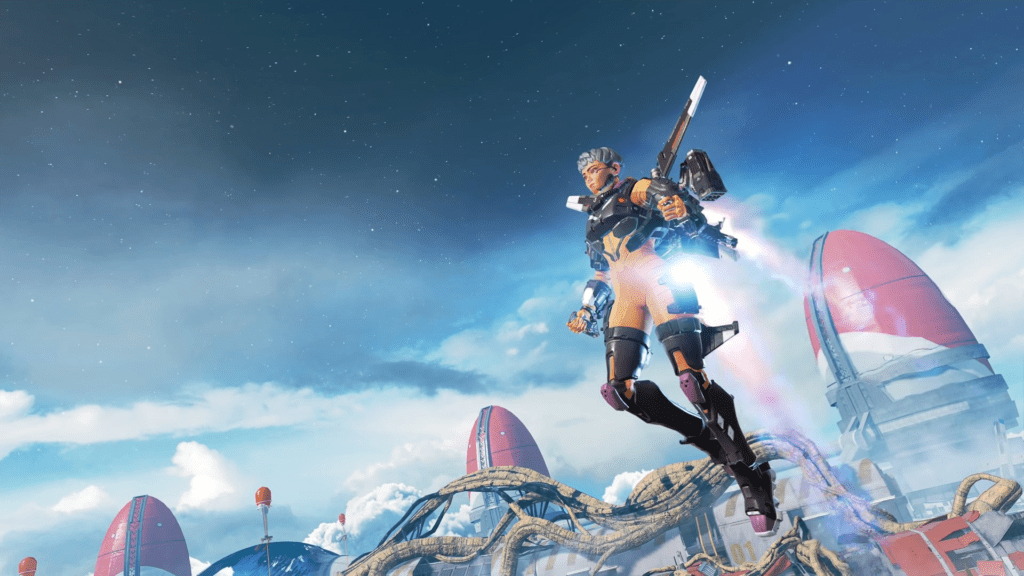
What Makes Apex Legends a Feminist First-Person Shooter Game
Reason #1: First and Foremost, the Strength (Literally and Figuratively) of Apex Legends’ Femme and BIPOC Characters
It’s easy to say that Apex Legends is a game worthy of attention for diversity and inclusion with an ever-growing cast of characters with different tones, bodies, gender identities, sexual preferences, accents, and class backgrounds, all tied up in interesting lore. But I think we need to commend developer Respawn Entertainment for committing to feminist gaming in a tangible way.
Some of the strongest offensive skill sets are given to its femme characters, even from Day 1. Yes, the first healer, Lifeline, was a femme character (pretty normal for video games). But also at Day 1 were soldier powerhouse Bangalore and portal attacker Wraith, the latter of whom is still the most frequently picked character even as newer characters have been added. The game has continued with this route, giving flying powers to Asian-American military-daughter inspired Valkyrie and some of the most brutally fierce fighting skills to new scientist-robot Ash. This is a big deal. These assets could easily be given to male characters, or even just one token female, but Respawn has again and again made this choice.
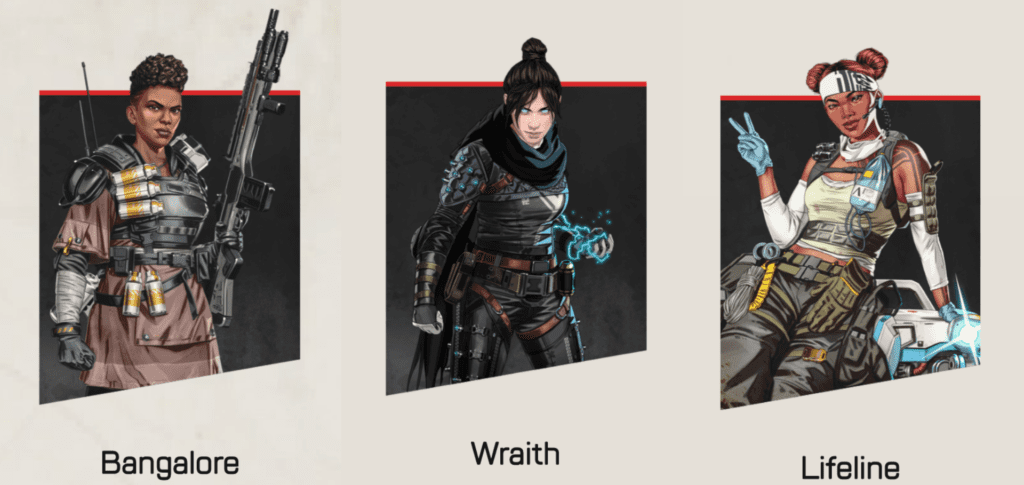
Over the past weeks of Apex matches, I’ve been pleasantly stunned to see teams again and again of only femme characters. That speaks to how good those characters are. I have never in my life played another game where this has been the case, much less because there’s usually only one. Competitor Fortnite randomized binary gender bodies for much of its gameplay precisely because they were afraid of femme characters getting disrespected, but that’s avoidance and not empowerment.
Diversity in Apex Legends
Furthermore, since Day 1, Apex‘s roster has included nonbinary super tracker Bloodhound as well as male body types we don’t traditionally see in games with poison trap-layer Caustic and shield defender Gibraltar. Femme characters in Apex Legends do not have hilariously skimpy armor or over-sexualized bodies; they may be beautiful, which is OK, because womxn are beautiful. But these characters are strong, and their beauty is not a crutch.
For gamers who don’t identify as cis- hetero- white men, it’s a beautiful experience to choose someone who resembles you and know that they’re a badass in their own right (and that you’re not just picking them because they’re the only woman). And, for those who are cis- (white) men, I’m excited that some of the best options in this game require them to play in a body experience that they don’t have—something the rest of us have had to do with most gaming since its advent.
Reason #2: The Game’s Fundamental Design Empowers Different Styles of Play, Learning, and Communication—Traits Notably Lacking in Halo Infinite’s Multiplayer
Price wrote in her essay:
I say all of this as someone with a deep love of competitive video games, casual and ranked alike. But this love has been consistently compromised by design which incentivizes intra-team competition as much as it does competition with your opponents—and the complete lack of a casual social space where players can meet new people without the pretense of competition. Halo’s sandboxes are messy and fun, players should be given the opportunity to explore them without needing to organize a group for custom game modes.
I appreciated Price’s vulnerability and honesty in her essay. At the actual design level, I think there are three characteristics of Apex Legends in particular that demonstrate what a more equitable future in competitive gaming looks like:
A) Most Important: a Finessed Non-Verbal Communication System That Encourages Camaraderie
I’ve been a big fan of Apex Legends’ ping system since Day 1, and I was impressed that it’s only improved since I last played. The ping wheel allows for you to share opinions on where to land, say that you’re exploring an area, share intel about enemies, and more. The care taken to design this system showcases a more inclusive approach to competitive gaming.
Empowering Players Without Relying on Mics
For years, games and the people who play them have prioritized mics as it gives an unprecedented advantage to online teams. Destiny 2 has a feature that indicates when an opposing team was using a mic chatroom, letting you know that you’re about to get schooled unless you jump in with your own. Even in Apex Legends’ optional social “clubs” feature, you’ll see tons of groups with tags that say #MicsRequired.
For people without male voices or with accents of any kind, mics are an extremely dangerous realm to play in. Some people say really horrible things in these games, about you or to you or just about communities in general. These derogatory, inappropriate, and hateful comments can ruin your whole day, much less a game or a hobby for you. Apex Legends designed around this by investing time and energy into creating their ping system. While you still can use mics, Apex also includes a 1-click “MUTE SQUAD” option when loading into a match, and also has a menu feature that disables any incoming or outgoing voice chat. The game just feels a lot safer to me, knowing I’m not going to accidentally hear something heinous just by logging in.

I’ve been in matches where I’ve been frustrated by teammates that immediately log out after getting downed, or who sprint across the map with reckless abandon, or who selfishly loot a teammate’s dead body. But, I also frequently have fond interactions with random teammates.
The Brilliance of Apex’s Ping System
Once as Valkyrie, I was trapped in a building with Wattson where we had no weapons. She started throwing ultimate charge-ups on the ground and pinging them, and I realized she knew I could use Valkyrie’s wings to fly us out of there. Another time when I was Wattson, I was able to pick up the banners for both of my downed teammates, get them to safety, and created a little safe zone using my electric walls and shield defense. I went and fetched weapons, and my teammates jumped up and down and pinged the “thank you” key multiple times—and later, we won.
There are times where I’ve asked for a shotgun bolt or sniper ammo using the game’s inventory pinging system, and teammates immediately deliver, and vice versa. It’s really nice to just be helpful in a world where we don’t always get to support others. Another time, an Octane sprinted back and forth to safeguard our third teammate who was low on health across a dangerous patch, using the directional “go here” commands to indicate the safest path. I watched a Pathfinder win the game even after I had died in the ring, and when I DM’d them to say “Congrats, awesome job,” they replied, “Thank you, I’m just sorry I couldn’t revive you.”
Fundamental Game Design Choices Make Apex Players Kinder People
This is all to say, the game makes fundamental design choices that can encourage camaraderie, patience, and respect. That can be even as simple as the Apex load screen that says, “Sharing is caring: make sure your teammates have what they need to succeed.”
Respawn has invested in kindness as a part of competition. It starts with something as simple as adding the “thank you” ping to begin with. It then grows by responding to player feedback and adding a ping for “you’re welcome.” I enjoy getting to be a player who’s looking for out my teammates, and I enjoy it even more when I know they’ve got my back, too.
B) Rewarding Different Play Styles
Some days on Apex, I just suck at shooting. The vibes are off. Those days, I instead focus on sharing resources, reviving teammates, building defenses, doing reconnaissance, and just communicating clearly, which is key in winning. I’ve won multiple games of Apex Legends where I may have one or no kills, but where I know I added value to my team by using Wattson’s electric defense systems or using my patient stealth skills to traverse a dangerous map alone to bring both teammates to respawn beacons.
This is made possible by Respawn’s design choices. There are varied maps with different places to drop depending on style. Varied character skill sets empower different player skill sets. Perhaps most of all is Respawn’s commitment to frequently rolling out new Apex modes that are significantly different in gameplay (including the fast-paced Arena and slow-burn Fight or Fright during Halloween), allowing players to shine in new lights.
In comparison, with Halo, there’s really only one skill that matters, and that’s shooting. For Apex’s biggest competitor, Fortnite, the only differentiation is in player skill, not character, and so those who have missed the boat on learning how to quickly build fortresses or shoot with the newest gun will always fail to catch up.
C) Time to Learn
Battle royale is a long game mode by nature. By definition, there are a variety of encounters that will occur in any match, much less a player’s lifetime with the game. Unless you immediately drop into a hotzone, players in Apex Legends usually have several minutes at the start of a game to recalibrate themselves to jumping, running, choosing guns, and figuring out their character’s skills. There is no buffer in a game like Halo.
From a story perspective, with Apex Legends, you’re at most missing out on two to three years of relatively casual lore that can easily be caught up on. From a gameplay perspective, Respawn releases a new map annually—everyone starts fresh all over again.
Compared to Halo Infinite, I was battling people who had literally grown up with these modes, these weapons, these characters. I want to be clear: I’m really happy for all the Halo dudes I know who are loving the brilliant version of the childhood series they loved. I’m just saying that not all of us got to have an Xbox where we could play first-person shooters as kids. I have not played on the same maps for 20 years, and it shows. When I think about what the future of competitive gaming looks like, I want to keep seeing games that build on beloved favorites as well as be unafraid to create something truly new.

Reason #3: Apex Legends Badges Gave Players a Voice to Share #StopAsianHate, Black Lives Matter, and LGTBQ+ Rights—and When on a Formidable Player, These Have an Impact
Player cards show up throughout each match—when you first meet your team, when you see the leading winning team in your arena, when you see who kills you. These cards are a way for players to demonstrate how freaking good they are at this game with stats about kill count, fellow players revived, damage done, etc. These player cards serve as a way to intimidate others, to make players respect you. On these cards are three slots for badges.
In 2020, Respawn created these cause-oriented badges (they didn’t have to) and made them free (they definitely didn’t have to do that—in comparison, Bungie released a paid #BlackLivesMatter banner for Destiny 2 that barely anyone bought or used or saw). So when you see a good player, there’s an automatic sense of respect, and to get to use that platform to share a message is significant.
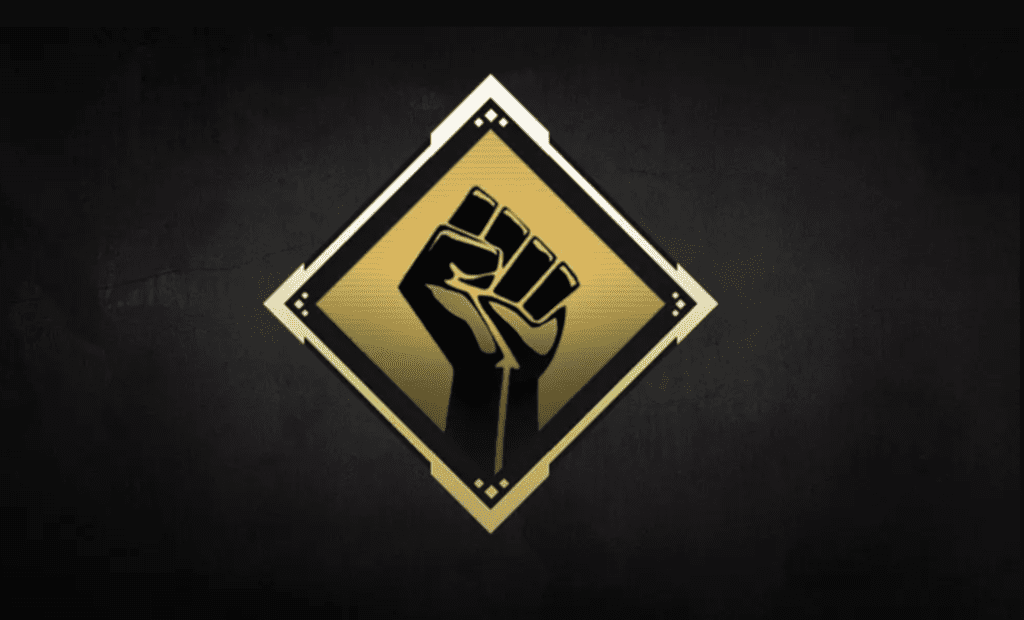
The Future of Apex Legends
Apex Legends’ Arena mode is a great sign of things to come. I’d love to see more game variants that allow for different play styles. Imagine a Capture the Flag mode that would empower defensive-heavy players to demonstrate their skills and offer value to the team. (Author’s note: I wrote that line a month ago, and sure enough, Apex Legends just dropped a brand new, limited edition 9 vs. 9 “control” mode that has players defend/attack areas on a map. Yes!!!) Or something along the lines of treasure hunting for players who love to traverse the map. I was a big fan of Destiny 2’s Gambit mode, which combined PVE with PVP; since Apex has already started adding monsters and beasts to maps, why not take it a step further?
Apex Legends is unlike any other game I’ve ever played. Sure, it’s a battle royale with a freemium model, it’s a first-person shooter, and, yes, I suck at it a lot of the time. But from the outset, Respawn has made a quiet and persistent commitment to diversity, equity, and inclusion. Apex Legends is one of the most feminist games I’ve ever played.
So, thanks Respawn. I see you. I appreciate you.
Amanda Tien (she/her or they) loves video games where she can pet dogs, punch bad guys, make friends, and have a good cry. She started writing for the site in 2020, and became an editor in 2022. She enjoys writing about mystery games, indies, and strong femme protagonists.
Her work has also been published in Unwinnable Monthly (click here to read her cover feature on Nancy Drew games), Salt Hill Journal, Poets.org, Litro Magazine, Public Books, and more. She was the Co-Founder and Editor-in-Chief of Columbia University's Culinarian Magazine, and served for two years as the Managing Editor of Aster(ix) Literary Journal.
She recently graduated with a MFA (Master of Fine Arts) in Creative Writing from the University of Pittsburgh. Her writing, art, graphic design, and marketing work can be viewed at www.amandatien.com.
She does not post a lot on social, but you can find her on X and on Instagram.


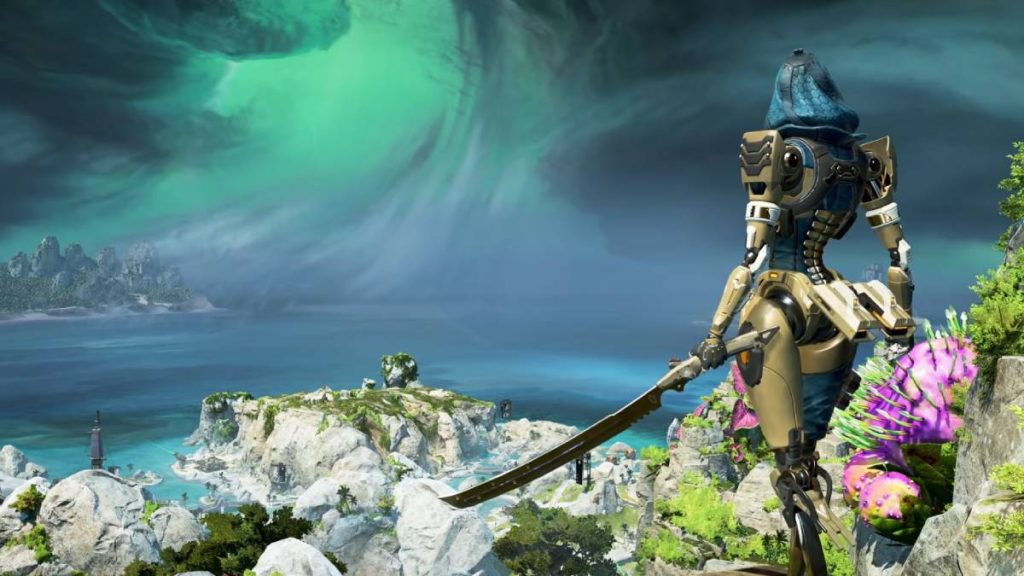





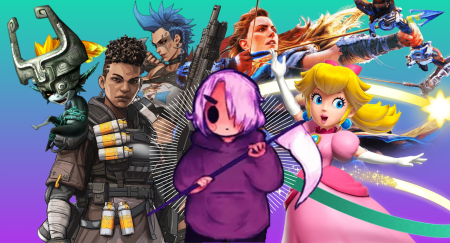
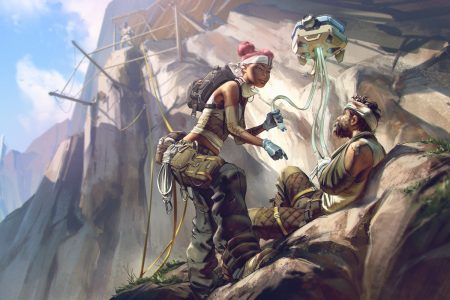


“Competitor Fortnite randomized binary gender bodies for much of its gameplay precisely because they were afraid of femme characters getting disrespected, but that’s avoidance and not empowerment.”
Chills! Amazing piece, Amanda!
Appreciate you David!